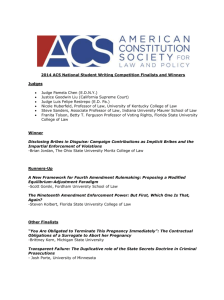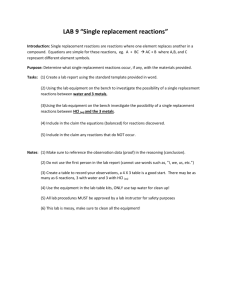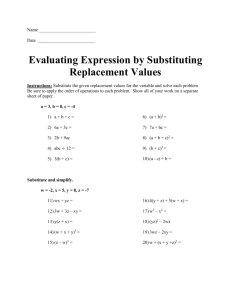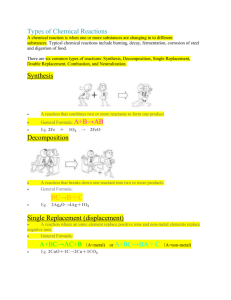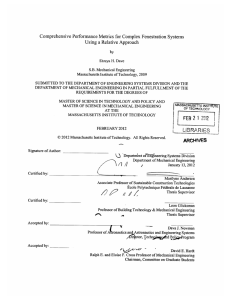Proposed Modification to the Florida Building Code
advertisement
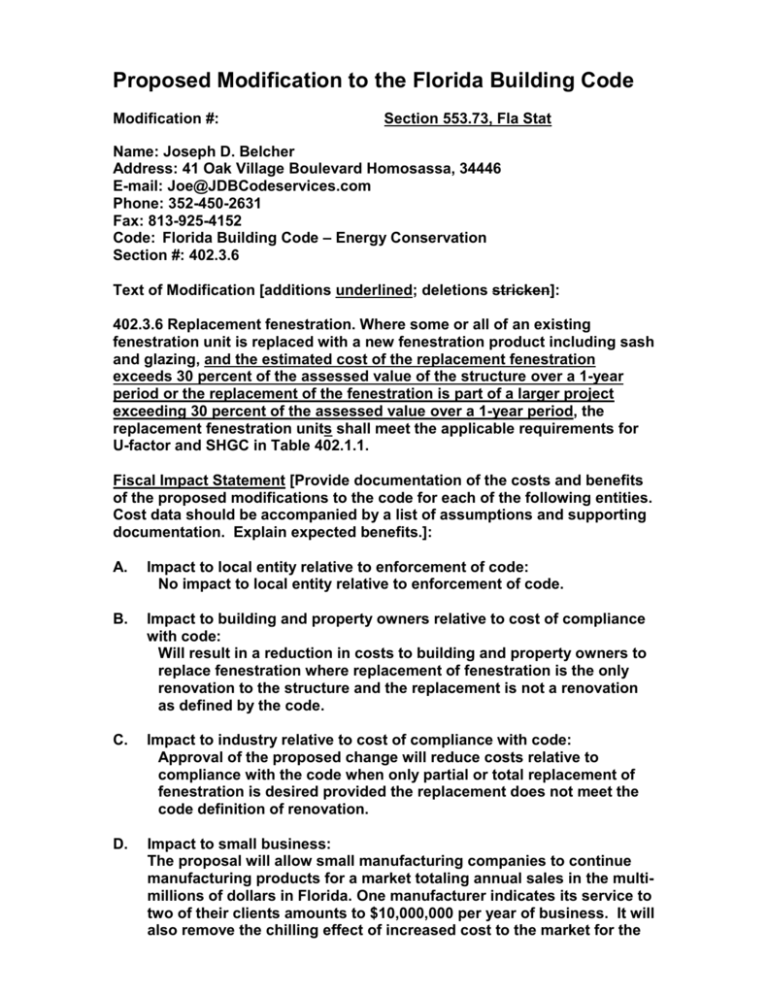
Proposed Modification to the Florida Building Code Modification #: Section 553.73, Fla Stat Name: Joseph D. Belcher Address: 41 Oak Village Boulevard Homosassa, 34446 E-mail: Joe@JDBCodeservices.com Phone: 352-450-2631 Fax: 813-925-4152 Code: Florida Building Code – Energy Conservation Section #: 402.3.6 Text of Modification [additions underlined; deletions stricken]: 402.3.6 Replacement fenestration. Where some or all of an existing fenestration unit is replaced with a new fenestration product including sash and glazing, and the estimated cost of the replacement fenestration exceeds 30 percent of the assessed value of the structure over a 1-year period or the replacement of the fenestration is part of a larger project exceeding 30 percent of the assessed value over a 1-year period, the replacement fenestration units shall meet the applicable requirements for U-factor and SHGC in Table 402.1.1. Fiscal Impact Statement [Provide documentation of the costs and benefits of the proposed modifications to the code for each of the following entities. Cost data should be accompanied by a list of assumptions and supporting documentation. Explain expected benefits.]: A. Impact to local entity relative to enforcement of code: No impact to local entity relative to enforcement of code. B. Impact to building and property owners relative to cost of compliance with code: Will result in a reduction in costs to building and property owners to replace fenestration where replacement of fenestration is the only renovation to the structure and the replacement is not a renovation as defined by the code. C. Impact to industry relative to cost of compliance with code: Approval of the proposed change will reduce costs relative to compliance with the code when only partial or total replacement of fenestration is desired provided the replacement does not meet the code definition of renovation. D. Impact to small business: The proposal will allow small manufacturing companies to continue manufacturing products for a market totaling annual sales in the multimillions of dollars in Florida. One manufacturer indicates its service to two of their clients amounts to $10,000,000 per year of business. It will also remove the chilling effect of increased cost to the market for the small contractor, the distributors, and the dealers specializing in fenestration replacement on home improvement projects where no other improvements are contemplated. Rationale [Provide an explanation of why you would like this Proposed Modification to the Florida Building Code.]: The current provisions fall within the glitch criteria because they create a conflict within the code. Chapter 1 at Table 101.4 Note d incorporates statutory language defining renovations. The language of Note d limits the application of the energy provisions of the code to alterations to the building envelope to those exceeding 30 percent of the assessed value of the structure over a 1-year period. Section 402.3.6 requires all replaced fenestration to meet the current energy provisions of the code. The change has a Florida specific need to allow conformance with the definition and requirements for renovated buildings as renovations relate to energy code compliance contained in Chapters 553.902(3) and 553.906, Florida Statute “(3) “Renovated building” means a residential or nonresidential building undergoing alteration that varies or changes insulation, HVAC systems, water heating systems, or exterior envelope conditions, provided the estimated cost of renovation exceeds 30 percent of the assessed value of the structure.” “553.906 Thermal efficiency standards for renovated buildings.—Thermal designs and operations for renovated buildings for which building permits are obtained after March 15, 1979, shall take into account insulation; windows; infiltration; HVAC, service water heating, energy distribution, lighting, energy managing, and auxiliary systems design and equipment selection and performance. Such buildings shall not be required to meet standards more stringent than the provisions of the Florida Energy Efficiency Code for Building Construction. These standards apply only to those portions of the structure which are actually renovated” (Emphasis provided.) The impact on small business if this glitch is allowed to stand will be a chilling effect on the fenestration replacement market for small contractors, distributors, dealers specializing in fenestration replacement, and some window manufacturers. In the current state of the economy, requiring the upgrade of replacement fenestration to meet the criteria for new construction will increase the cost by estimates ranging from 15 percent to 45 percent and more. The fragile market for the small businesses specializing in alterations involving the replacement of fenestration cannot withstand any increase. In addition, I have been involved with codes for more than 35 years. I spent ten years in the public sector culminating as the building official for the City of Gainesville before entering the private sector and establishing a codes program for a statewide trade association. In my view the proper application of the existing code is as follows. The FBC-EC Section 101.4.1, Existing Buildings, is a sub-section to the section entitled Applicability. The section clearly states existing buildings SHALL meet the criteria in Table 101.4.1. Table 101.4.1 contains a row entitled Renovation which applies to the building exterior envelope and other items when components are being changed. The title of the row, Renovation, is annotated with a Note d superscript. Note d, among other items, states that changes to the exterior envelope are covered, PROVIDED, the renovation exceeds 30 percent of the assessed value of structure. The note further refers the user to the definition for renovation in Chapter 2, Definitions. The code definition of renovation in part states “Any structural repair, reconstruction, or restoration to a structure, the costs of which equals or exceeds, over a 1year period, a cumulative total of 30 percent of the assessed value of the structure…” The definition goes on to describe the when of applying the assessed value. The permit applicant replacing the fenestration should check the value of the fenestration replacement against the assessed value of the structure. If the fenestration replacement project is less than 30 percent of the assessed value of the structure, the FBC-EC does not apply. The other requirements of the code such as wind and water resistance apply, the Florida Building Code – Energy Conservation does not apply. The user never gets to Chapter 4 in this scenario. However, as evidenced by the petition for Declaratory Statement DS 2012021, there is considerable controversy over the proper application of the code. This is an effort to provide clarification to the application of Section 402.3.6 and correct a glitch. Please explain how the proposed modification meets the following requirements: 1. Has a reasonable and substantial connection with the health, safety, and welfare of the general public: The proposed amendment will positively affect the health, safety, and welfare of the general public by eliminating a glitch by clarifying the application of Section 402.3.6 is limited to the replacement of fenestration when such replacement meets the code definition of building renovation. 2. Strengthens or improves the code, and provides equivalent or better products, methods, or systems of construction: The proposed amendment will improve the code by eliminating a glitch by clarifying the application of Section 402.3.6 is limited to the replacement of fenestration when such replacement meets the code definition of building renovation. The proposed amendment properly correlates the adoption of ASCE 7-10 with ASTM E 1996 within the Florida Building Code, Building which strengthens and improves the by not posing provisions greater than intended by the adopted reference standard. 3. Does not discriminate against materials, products, methods, or systems of construction of demonstrated capabilities: The proposed amendment does not discriminate against materials, products, methods, or systems of construction of demonstrated capabilities. 4. Does not degrade the effectiveness of the code: The proposed amendment will positively eliminate a glitch by clarifying the application of Section 402.3.6 is limited to the replacement of fenestration when such replacement meets the code definition of building renovation which does not degrade the effectiveness of the code. 5. The conflict occurs between provisions that are a Florida Specific Amendment codifying Florida Statute and the provisions of the base code. The provisions of Table 101.4.1 The provisions are not addressed in the IBC 2009 as they are a Florida Specific Amendment intended to codify statutory provisions related to construction. 6. The amendment demonstrates by evidence or data that the geographical jurisdiction of Florida exhibits a need to strengthen the foundation code beyond the needs or regional variations addressed by the foundation code, and why the proposed amendment applies to this state. The amendment is intended to address a glitch in the code and is not addressed in the base code. 7. The proposed amendment was submitted or attempted to be included in the foundation codes to avoid resubmission to the Florida Building Code amendment process. The amendment will not be submitted to the base code as it codifies language contained in Florida Statute.
